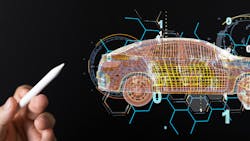The number of available car models in the U.S. has grown significantly over the last two decades.
Across more than 40 automakers, data from research group Statista estimates there are around 300 different models of vehicles available for purchase in the U.S., and each of those models is becoming increasingly unique due to new ADAS, computers and other technologies being installed every year.
Today’s vehicles are essentially family-sized computers on wheels, and Don Putney, president of Collision Equipment Experts in Algonquin, Illinois, says gone are the days that shops will be able to fix every vehicle that comes to their door.
“Most manufacturers seem to require something different,” Putney says. “They’re asking to have repairs done with their approved equipment by vendors that are approved and certified.”
When there are this many cars in the country, your shop is going to have to specialize and choose not only which vehicles you’ll be able to work on, but also what training and tools you invest in.
The Problem
As vehicles become increasingly more reliant on high-tech components such as sensors and cameras, OEMs are becoming more stringent on how they expect repairs to be performed. Putney says he sees that as a challenge for shops since a lot of operations currently use aftermarket tools.
“Right now, a lot of shops are using aftermarket equipment or subcontractors that use aftermarket calibration equipment to calibrate these cars,” he says. “The car manufacturers are asking to have repairs done with their approved equipment by vendors that are approved and certified. They really would like to see shops take vehicles to certified vendors for calibrations.”
Though it can be tempting to get the most bang for your buck by buying aftermarket tools that work across different vehicle makes, Putney says it may not be too long before that’s not a viable service model. So, what is a shop to do instead?
The Solution
The short answer, Putney says, is specialization and certification. Though not a fix-all solution, figuring out what vehicles you work on the most and focusing on those is a good way to improve efficiency and maximize your staff’s time and energy.
“I was in a shop and their owner told me they were only going to fix vehicles from the Big 3, because those made up 80 percent of the vehicles in their area. It doesn't make sense to buy the tools and the training for other vehicles if there's a small market for them in your area,” he says. “The first thing shops should do is see what cars are in their market. I don't think that fixing everything that comes to your door is going to last much longer.”
The research doesn’t need to be all-encompassing, but taking inventory of what makes and models of vehicles you’ve had come through your shop in the last 12 to 24 months, as well as looking at all vehicles registered in your market, can help your team figure out what you should prioritize. That, in turn, will help you get started in planning what tools and training you’ll need.
“You'll want to do a combination of a proactive and reactive approach,” Putney says. “I think you want to take a proactive approach to see what vehicles people are buying in your area, but also then look at your history. If you're close to a Chevy dealer, maybe you should look into becoming a GM-certified shop.”
Most OEMs list what tools and qualifications are needed to become a certified collision repair shop. Depending on what the data from your research spells out, Putney says going for multiple certifications is a good idea.
Some OEMs are easier to work with and become certified with than others. Putney says American OEMs tend to be a little more lenient with their tooling requirements, focusing on the specs of the tool instead of the specific tool itself. European OEMs tend to have tighter requirements for theirs and will prescribe a specific tool that has to be used, and in some cases, they’ll even require that you purchase that tool directly from them.
“Once you get to more specialized vehicles like EVs, then domestic manufacturers will call out more specific tools,” Putney says. “But for a majority of what shops are going to fix, they’ll say ‘This is the requirement for the tool,’ but they won’t prescribe a specific tool.”
The Aftermath
The research and due diligence into certification are only half the battle. For as important as investing in specialty equipment and the training to use it is, Putney says it won’t do any good for your shop if you don’t let people know you have that skillset and knowledge.
“You still have to market your shop well. Let people know you have the equipment to repair their vehicles,” he says. “Say that you're certified by the OEM and that you have the proper tools and training to do that, and you can start marketing yourself through your website and social media.”
On top of that, proactively forming relationships with dealerships in your area can be a good way to boost the volume of specific types of vehicles.
“If you're Ford-certified but you're not seeing a lot of Fords coming into your shop, go talk to the dealerships around you to see if you can work out a partnership,” Putney says. “A lot of times, if a customer is in an accident, they'll call their dealer and ask what shops to take the car to. If you're not seeing that uptick in traffic, you need to market better.”
The Takeaway
It’s no secret that the automotive industry as a whole is becoming more and more reliant on technology with every passing year.
It's important to have a plan to navigate that, and certification is a good starting point to help think about what tools and training your shop will need to succeed.
OEMs are becoming more scrutinous about how their vehicles are repaired. Putney says research shows that customers blame OEMs in some part if their vehicle isn’t fixed properly after an accident. OEMs want to protect their reputation, and Putney says that provides an opportunity for collision shops that are willing to take it.
”It's very important to manufacturers that their cars are fixed properly so they can keep that customer loyalty,” he says, “which means it's important for shops to have the correct tooling and training to fix those cars properly.”
About the Author

Noah Brown
Noah Brown is a freelance writer and former senior digital editor for 10 Missions Media, where he facilitated multimedia production several of the company's publications.
